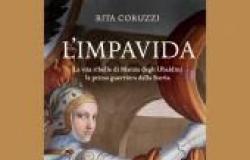On display is the white and Eurocentric art of an empire at its peak and then the “other” art which, from within an institution whose birth was a direct consequence of colonial policies, has almost followed a sort of journey in parallel, moving from the margins of anonymity to a growing protagonism that used, embraced and challenged imperial canons.
Put this way, it would seem like an exhibition of “white people” on the one hand, dated in their elongated portraits, in their idealized landscapes, in those genre scenes of a contemporaneity that reminds us, in 2024, of the images of history books and then of the ” blacks” of the new millennium, agile and direct in their very recent multimedia works, which demand the recognition they deserve and have ignored for too long. And yet there is more than a simple juxtaposition between the old that dominated and the new that suffered – and then rebelled – in this latest, spectacular narrative of the Royal Academy. In fact, if there is a comparison between old and new, from which we read that – in the golden years of colonial expansion in the West (hence philanthropism and the birth of academies such as the RA.) – art was a form of domestic colonization and there were few black artists who managed to become free men (a few more were models), it is also true that of the 50 artists on display all are Royal Academicians or in any case linked to the institution. People who have lived and made art while confronting the realities of power. It is the heart ofentanglement which, now as then, Art records and therefore denounces, replacing the violence of conflict with the strength of dialogue.
Entering, the first room is entirely dedicated to portraits of black men, created between the end of the 1700s and the beginning of the 1800s and coming from North American collections. In the center the half-bust in dark stone: Bust of a man, 1758 by Francis Harwood (1727-1783).
We know that the artist was British by birth, Florentine by adoption and that he had made a name for himself among the regulars of the grand tour to whom he sold sculptures inspired by ancient models, such as Bust of a man. However, nothing remains of the sculpted man. Who he was, what he did, whether he was the client or a model: these are questions without answers. Not even the nearby canvas: Portrait of a man. Probably Francis Barber, 1770, we know more than what we read in the caption, although the performer here is the famous Joshua Reynolds (1723-1792), a founding member of the Royal Academy.
Certainly Reynolds restores to his model with an opaque identity a stature that needs no introduction: the central pose against the romantic and windy background; the white collar of a scholar, a sketchy dressing gown. But Francis’ gaze is elsewhere. Maybe aimed at Africa? Remembering the crossing from the Atlantic which for many “anonymous” people like him was the first point beyond which life – if it didn’t end – changed anyway? It almost seems like this generic “man” or probable Francis, carries with him a truth too profound to leave room for a direct look between man and man. Between him, Reynolds and us.
Further on, another large portrait of Reynolds gives a key to understanding those ambitious and problematic years. In Portrait of George, Prince of Wales, later King George IV, 1787, the future king is canonically depicted in his imperialistic prestige symbolized not only by the Roman column in the background, but also by the presence of exotic servants. Specifically, a black boy whose name we not only don’t know, but we can only guess at his young face, his soft profile, the promptness with which he adjusts the sash of the strutting prince, weighed down by the numerous apparatuses of the order of the garter. The velvet cloak with the red cross, a heavy gold chain, the garter on the calf and, finally, the plumed hat that the regent does not wear, but is taken up by the foamy hair of a flamingo pink. In the monarchical system, servants had (and have) their hierarchical elegance and not many people came to serve the king. But maybe there’s a reason why this young man man had obtained such a privilege. In 1787 the wars of American independence had recently ended. In the colonies, the abolitionists’ revolts were strengthened by the result obtained and it is plausible that, in the Kingdom, concessions to the populations who emigrated from the colonies were a way to calm the waters.
Watson and the shark1778, facing King George, is another reference to a contemporaneity defined by turbulent relations with the territories on the other side of the ocean.

The client of the work, Brook Watson, a Bostonian of origin but naturalized English, had survived a shark attack in his youth. The episode, romanticized by the artist: John Copley (1838-1815, like Watson, American by origin, but later emigrated to England) caused a sensation when it was exhibited at the annual exhibition of the Royal Academy in 1778. The incident sea staged the dangers of the Atlantic trade, presenting to the elite audience of the academy a news event in which the solid presence of the black sailor who holds out his hand to Watson in a symbolic, dramatic lifting gesture, could be read as a reference to the need to maintain “good” relations with colonized populations. Armada, 2017-2019 by Hew Locke occupies the central area of the room.

The installation brings together models of boats that Locke has collected for years. The sailing ship Mayflower, the merchant ship The Bounty, cruise ships such as the Windrush and pirate ships. Some boats are new, others bought, still others assembled by Locke from discarded objects. “It’s a collection of ghosts of the past and realities of today that navigate together,” explains the artist. Those imperial ghosts masters of the seas? Our battered and overloaded ships carrying migrants?
Colonialism with its cultural, as well as territorial, impositions affects the landscapes of William Hodges (1744-1797). Views that conceptually, in terms of compositions, distribution of light, depersonalization of distant and very small figures, do not distance themselves in any way from the genre from Claude Lorrain to John Constable (a contemporary of Hodges). But Tahiti and Benares (present-day Varanasi) are the places painted in the European style and which deliberately omit from the pictorial space the atrocities committed to domesticate the conquered lands, presented as paradises of idleness and sensuality. They contrast these visions of pleasant places Primitive Matters, Huts2010 e Woman moving up2023. The first work by Karen McLean (raised in Trinidad) is an installation composed of 7 huts (huts) made of wood and metal, positioned in front of black and white projections of 7 magnificent colonial homes in Port of Spain. Villas of an alienating opulence – belonging to leaders of Western religious orders, plantation owners and entrepreneurs, who impose themselves on the small, poor vernacular architecture, setting in motion a series of open questions, including of an ecological nature. Woman moving up by Ynka Shonibare, a British artist of Nigerian origins, has been exploring the trans-continental, trans-cultural, trans-linguistic and trans-artistic nature of hybrid identities like hers for decades.

Woman moving-up it is a woman, with a globe-shaped head, a healthy, solid physique, wearing early 20th century Western-made batik clothes, who is climbing a luxurious marble staircase with brass railings. Her back is bent. From the weight of the half-open suitcases from which you spill out laboriously bought “stuff”? From the metaphorical and real climb itself? There is the powerful, dignified determination of humility in this figure who seems to suffer the strain of all disadvantaged situations. The world is spinning in her head, literally. Her suitcases and her clothes identify her instantly: she is a migrant in search of fortune in a West that thrives on the luxury accumulated thanks to the exploitation of those who have to work, emigrate and climb those stairs. What remains of her? She alone persists, one step after another, with the world on top of her; as did the 6 million African Americans who changed the West from 1917 to 1960 from the southern United States.
The theme of the journey closes the exhibition in a symbolic immersion in water, seen as a dimension that preserves our past, returning it to us in its perennial movement. On the walls are seascapes by William Turner (1775-1851).

Whalers, 1845 (whalers), is a glorification of the frightening aquatic utopia and the technological prowess of industrial England, ruler of sea trade. Turner’s landscapes perplexed the audience of the Royal Academy, confused by the modernity that united figuration and abstraction, by the essentiality of the message, by the fluency of the use of color and the universality of a creative approach above and outside the canon. Whale falls, 2017 (a falling whale), opposite, by Gallagher is in dialogue with Turner.

Not only does the African-American, British and European author declare herself indebted to Turner’s inspiration, but she also carries forward his ambition to capture aquatic life. In Whale falls, a very delicate work, on paper, descends into the seabed together with the whales rendered by black cuttings applied on the background in shades of blue. A descent to the origins which, in the wake of a natural phenomenon – the carcasses of dying whales fall to the bottom of the sea where they become nourishment for underwater creatures, sustaining them for years – refers to the Middle Passage. That triangular route between Africa, North America and Great Britain in which many lost their lives, falling to the bottom of the Atlantic like whales.
The sounds of the sea by Vertigo Sea, 2015 (monumental three-screen video by John Akomfrah), serve as an epilogue to this last section of the exhibition, summarizing all the themes – colonialism, slavery, migration, the relationship between man and the sea and art as a witness, legacy and parameter of denunciation and beauty. Art that renews, regenerates and changes.
Entangled Pasts, 1768–now, Art, Colonialism and Change
Royal Academy | Main Galleries | Burlington House
3 February – 28 April 2024
Cover image: Installation. ‘Entangled Pasts, 1768–now. Art, Colonialism and Change’ at the Royal Academy of Arts, London (3 February – 28 April 2024), John Akomfrah CBE RA, Vertigo Sea, 2015, Courtesy Smoking Dogs Films and Lisson Gallery. Photo © Royal Academy of Arts, London / David Parry. © Smoking Dogs Films.











